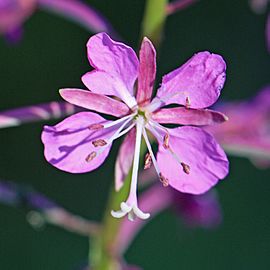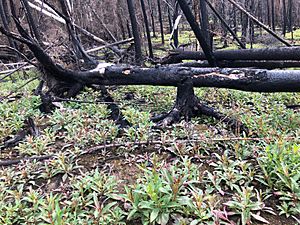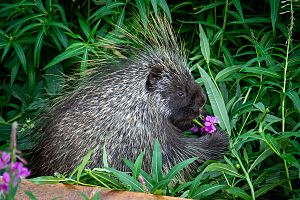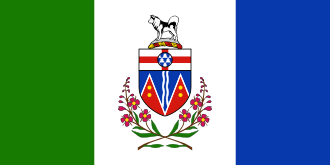Chamaenerion angustifolium facts for kids
Quick facts for kids Chamaenerion angustifolium |
|
|---|---|
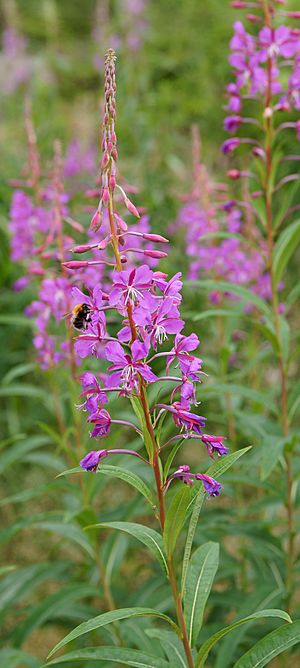 |
|
| Scientific classification | |
| Genus: |
Chamaenerion
|
| Species: |
angustifolium
|
| Synonyms | |
|
|
Chamaenerion angustifolium is a beautiful flowering plant that lives for many years. It belongs to the willowherb family. In North America, it's often called fireweed. In Britain and Ireland, people know it as rosebay willowherb. During World War II, it was even called bombweed because it grew quickly on bombed city sites. It's also known by other scientific names like Chamerion angustifolium and Epilobium angustifolium. This plant grows naturally across the cool, northern parts of the world, including large boreal forests.
Contents
What Does Fireweed Look Like?
Fireweed plants have reddish stems that usually stand straight up. They can grow quite tall, from about 1.5 to 8 feet (0.5 to 2.5 meters) high. Their leaves are arranged in a spiral pattern around the stem. They are long, narrow, and have smooth edges.
Fireweed Flowers
The flowers grow in a tall, tapered cluster at the top of the stem. They bloom from the bottom upwards. Each flower is about 0.8 to 1.2 inches (2 to 3 cm) wide. They have four bright pink to magenta petals. Behind the petals are four narrower pink sepals. The plant's style, which is part of the flower, sticks out and has four parts.
Seeds and How They Spread
After the flowers bloom, the plant forms upright, reddish-brown seed pods. These pods split open from the top. Inside, there are many tiny brown seeds. A single plant can produce about 80,000 seeds! Each seed has silky hairs, which help the wind carry them far away. This makes fireweed very good at spreading. Once it starts growing in an area, its underground roots also help it spread, forming large patches.
Fireweed's Family Tree
Scientists group plants into different families and types. Fireweed is part of the Chamaenerion group. Sometimes, it's also linked to the Epilobium group. This is because scientists look at different features, like how the leaves are arranged or the shape of the flowers, to decide how to classify plants.
What Do the Names Mean?
The scientific name Chamaenerion means 'dwarf-oleander'. The second part, angustifolium, is Latin for 'narrow-leaved'. You might find this name on other plants too!
The common name "rosebay" comes from how the flowers look a bit like wild roses. Its leaves also look similar to bay leaves. The name "fireweed" comes from how quickly it grows in places after forest fires or other disturbances.
Where Fireweed Grows and Lives
Fireweed loves open areas with lots of light. It grows well in wet soils, from chalky to slightly acidic. It's a "pioneer species," meaning it's one of the first plants to grow in new or disturbed areas. Think of places like forest fire sites or cleared land.
It grows and flowers as long as there's open space and sunlight. After about five years, other trees and bushes start to grow bigger. Then, fireweed begins to be replaced. But its seeds can stay alive in the soil for many years. When a new fire or disturbance happens, the seeds wake up and start to grow. Sometimes, after a big fire, an area can be completely covered in beautiful pink fireweed.
Fireweed is very good at spreading. Its seeds can travel far, helping it quickly move into new disturbed places. Once it starts growing, it spreads even more using its underground roots. It can even help prevent new fires because it grows so quickly.
In Britain, fireweed was rare in the 1700s. But it became much more common as railways expanded, which disturbed the soil. During World War II, it earned the nickname "bombweed" because it quickly grew in bomb craters.
Animals like bears and elk enjoy eating fireweed.
Who Visits Fireweed Flowers?
Many different insects visit fireweed flowers. They help the plant make seeds. Some types of moths, like the elephant hawk moth and the white-lined sphinx moth, even lay their eggs on fireweed plants. Their caterpillars then eat the leaves.
How People Use Fireweed
Even though it's not usually grown for food, fireweed is easy to find. The very young shoots and leaves can be cooked and eaten. You can also eat the young flowers. The stems of older plants can be split open to get to the soft, edible inside part. Its leaves can also be used to make a type of tea.
Native American and Siberian people have traditionally collected the young shoots in spring. They mix them with other green vegetables. As the plant gets older, its leaves become tougher and a bit bitter. Some Native American groups collect the stems at this stage, peel them, and eat them raw. When prepared fresh, fireweed is a good source of vitamin C and provitamin A. The Denaʼina people even add fireweed to their dogs' food. They also use it as a medicine. They put a piece of the raw stem on boils or cuts to help draw out pus and prevent the wound from healing too fast.
You can roast the root after scraping off the outside. But it can taste bitter. To make it less bitter, people collect the root before the plant flowers and remove the brown thread in the middle.
In Russia, fireweed is made into a popular tea called Ivan-Chai (Ivan-Tea). It has been made since the 1200s! This tea tastes rich and has a deep color, like black tea, but it doesn't have caffeine. It's often sold mixed with mint or thyme. Fireweed tea is also good for you because it has iron, copper, potassium, and calcium.
In the Yukon, people make jelly from fireweed flowers.
The honey made from fireweed is very special. It's often produced in cool places like the Pacific Northwest in the United States and countries in Scandinavia.
Helping the Land Recover
Because fireweed grows so quickly on disturbed land, it's useful for helping nature recover. When areas are logged, burned by fires, or have landslides, the ground can be left bare. This makes the soil more likely to wash away. Fireweed can help! It's resistant to fire and helps put nutrients back into the soil after a fire. It also quickly grows roots that hold the soil in place, preventing erosion.
Fireweed helps disturbed lands recover faster. It provides a green cover, which is good for animals to find new homes. It also attracts pollinators, which helps other plants grow again.
Fireweed in Culture
Fireweed is the official flower of the Yukon territory in Canada.
Because of its beauty, fireweed has been mentioned in poems and stories for a long time. The famous writer Rudyard Kipling wrote about it. In The Fellowship of the Ring, J. R. R. Tolkien mentioned fireweed growing where a bonfire had been.
Since it was one of the first plants to grow on bombed sites in World War II, fireweed often appears in British books written after the war. A children's book called Fireweed is about two runaway teenagers who meet on bomb sites where fireweed is growing. Another book, A Reflection of Rachel, talks about "Rose Pink Willow Herb" growing on abandoned bomb sites. The 1948 book Flower Fairies of the Wayside has a picture of 'The Rose-Bay Willow-Herb Fairy'. The poem says the fairy makes "All forlorn and ruined places... With a mass of rosy pink."
In 2002, rosebay willowherb was voted the official county flower of London.
Images for kids
See also
 In Spanish: Epilobio para niños
In Spanish: Epilobio para niños


